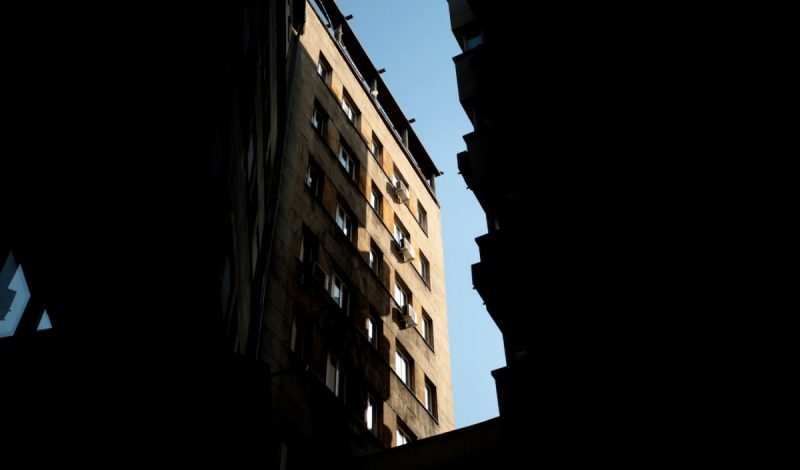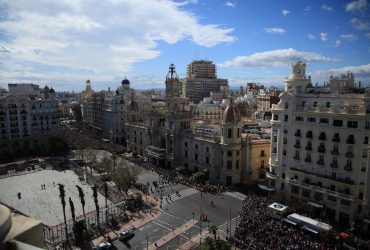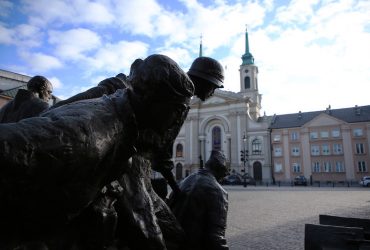Even before my departure for Sofia I had found information about the “free tour” of the city. Once I arrived in town, I found even more about the “association 365”: I discovered their “communist tour” that brings visitors to discover the city through the places, monuments and history of the village during the communist
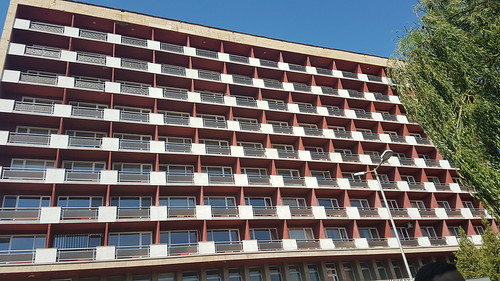 period. The appointment is in front of the courthouse, and we meet Vasili, our guide. After the first indications about the tour, we move in front of the Rila hotel, one of the first hotels in Sofia where Gagarin also stayed. Vasili, here, begin with a sort of “presentation” of the main characters of communism in Bulgaria, an excursus on the theory of communism and how many people who live in Sofia today tend to cancel (or try not to remember) that historical period.
period. The appointment is in front of the courthouse, and we meet Vasili, our guide. After the first indications about the tour, we move in front of the Rila hotel, one of the first hotels in Sofia where Gagarin also stayed. Vasili, here, begin with a sort of “presentation” of the main characters of communism in Bulgaria, an excursus on the theory of communism and how many people who live in Sofia today tend to cancel (or try not to remember) that historical period.
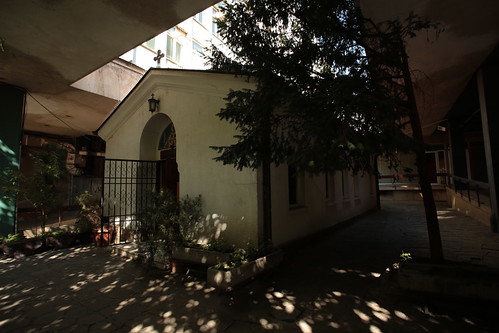 The history of communism in Bulgaria doesn’t go as the party leaders hoped and, in the end, the communist party even becomes illegal (in Bulgaria). But back to our days and the tour, with a stop at the small church of San Nicola, destroyed during the Second World War and then rebuilt. During the communist era, Bulgaria was an atheist country: it was not forbidden to have a religion, but since “religion is the opium of peoples” having a creed and going to church could have serious consequences for people’s private lives! This small church is hidden exactly because of that: surrounded by very tall buildings, the small cross on its top is hidden at the sight by a “marble junction” between two buildings (junction useless for other necessity).
The history of communism in Bulgaria doesn’t go as the party leaders hoped and, in the end, the communist party even becomes illegal (in Bulgaria). But back to our days and the tour, with a stop at the small church of San Nicola, destroyed during the Second World War and then rebuilt. During the communist era, Bulgaria was an atheist country: it was not forbidden to have a religion, but since “religion is the opium of peoples” having a creed and going to church could have serious consequences for people’s private lives! This small church is hidden exactly because of that: surrounded by very tall buildings, the small cross on its top is hidden at the sight by a “marble junction” between two buildings (junction useless for other necessity).
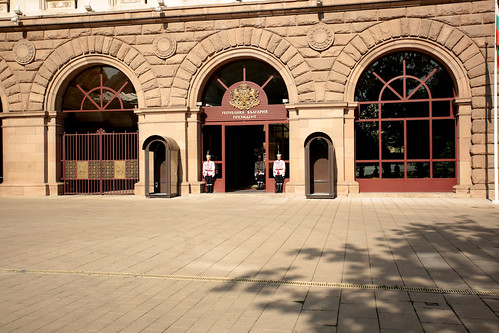 The walk passing in front of the building of the Presidency of the Republic (changing of the guard every hour) and Vassili continues his historical account of that period. In 1941 the countries of the axis forced Bulgaria, which had decided to remain neutral, to enter the war: it served them as territory to get to Greece and could not pass if the country continued to be impartial. And what did Bulgaria do?
The walk passing in front of the building of the Presidency of the Republic (changing of the guard every hour) and Vassili continues his historical account of that period. In 1941 the countries of the axis forced Bulgaria, which had decided to remain neutral, to enter the war: it served them as territory to get to Greece and could not pass if the country continued to be impartial. And what did Bulgaria do?
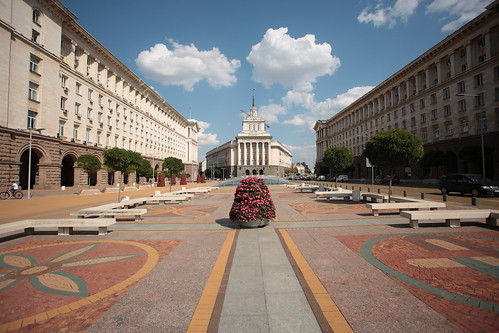 The government declared a symbolic war to the United Kingdom and the United States! Their profit? 12 air bombardments. We take a few steps and arrive at a large square called “Largo complex“: here there are three buildings built in the 50s/60s to demonstrate the strength of the Communist party. Above the structure of the town assembly, then, stood the communist red star (which was later removed); above the name, however, you can still see the symbol with sickle and hammer. Opposite the building, on the other side of the square (and the street) is a statue of Saint Sofia: this was put there to replace the statue of Lenin.
The government declared a symbolic war to the United Kingdom and the United States! Their profit? 12 air bombardments. We take a few steps and arrive at a large square called “Largo complex“: here there are three buildings built in the 50s/60s to demonstrate the strength of the Communist party. Above the structure of the town assembly, then, stood the communist red star (which was later removed); above the name, however, you can still see the symbol with sickle and hammer. Opposite the building, on the other side of the square (and the street) is a statue of Saint Sofia: this was put there to replace the statue of Lenin.
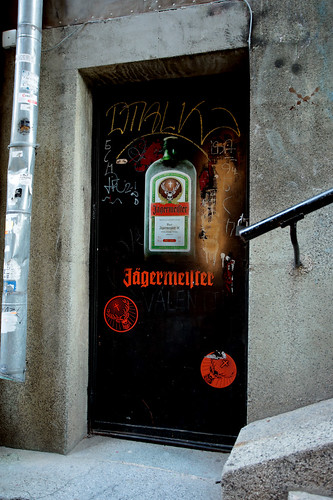 We move again, and the story of Vassili continues with some information about the “STASI“, the Bulgarian “communist secret police“, and the building where they kept their interrogation. We take a small road made by steps, and we stop in front of a little door, from which the STASI entered the people to who they wanted to ask questions. Many of the people who came through this door came out only to go to the labour camps. The next stop is in front of what was the royal palace, in front of which there was the mausoleum of Dimitrov, one of the leaders of the party: today it is no longer visible because it was destroyed in 1999 by the anti-communist government. The mausoleum was built in just six days, and bulldozers were used to destroy it because they failed the four attempts made with bombs and dynamite (this was because it was also an anti-nuclear shelter). The road between the palace and mausoleum was the one where took place the official parades. We move under the statue of Tsar Alexander II, in front of which is the building of the national assembly. From there we focused on the University of Sofia: it was one of the first in Bulgaria and, during the period of communism, education was also free for university students because it needed the population to be well-educated so that the country would work best “under the control and the rules of communism”. After a coffee break,
We move again, and the story of Vassili continues with some information about the “STASI“, the Bulgarian “communist secret police“, and the building where they kept their interrogation. We take a small road made by steps, and we stop in front of a little door, from which the STASI entered the people to who they wanted to ask questions. Many of the people who came through this door came out only to go to the labour camps. The next stop is in front of what was the royal palace, in front of which there was the mausoleum of Dimitrov, one of the leaders of the party: today it is no longer visible because it was destroyed in 1999 by the anti-communist government. The mausoleum was built in just six days, and bulldozers were used to destroy it because they failed the four attempts made with bombs and dynamite (this was because it was also an anti-nuclear shelter). The road between the palace and mausoleum was the one where took place the official parades. We move under the statue of Tsar Alexander II, in front of which is the building of the national assembly. From there we focused on the University of Sofia: it was one of the first in Bulgaria and, during the period of communism, education was also free for university students because it needed the population to be well-educated so that the country would work best “under the control and the rules of communism”. After a coffee break,
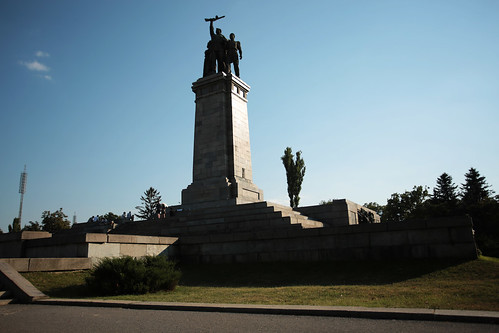 continue to the Monument to the Red Army. This monument is dedicated to the Russian soldiers who died in Bulgaria during the Second World War, but there is a small detail “against” this dedication: no Russian soldier died in Bulgaria! That happened because the Bulgarian government gave the order, during the war, not to oppose resistance to the Russian army when it entered the Bulgarian territory. The relief on the right side was, over the years, “victim” of acts of vandalism and demonstrative acts (as when everything was painted in pink).
continue to the Monument to the Red Army. This monument is dedicated to the Russian soldiers who died in Bulgaria during the Second World War, but there is a small detail “against” this dedication: no Russian soldier died in Bulgaria! That happened because the Bulgarian government gave the order, during the war, not to oppose resistance to the Russian army when it entered the Bulgarian territory. The relief on the right side was, over the years, “victim” of acts of vandalism and demonstrative acts (as when everything was painted in pink). 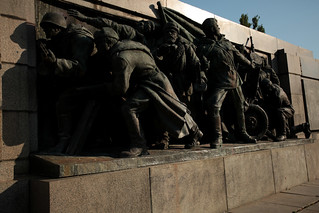 The walk continues through the story of the development of Bulgaria in that historical period. After the Second World War Bulgaria was very industrialised (in preparation for the last phase of communism), mostly in the light industry, related industry to food and the world of drinks; we must wait for the 50s and 60s for the light and energy sectors.
The walk continues through the story of the development of Bulgaria in that historical period. After the Second World War Bulgaria was very industrialised (in preparation for the last phase of communism), mostly in the light industry, related industry to food and the world of drinks; we must wait for the 50s and 60s for the light and energy sectors.
We stop in front of an area cordoned off because of work: here was a monument called “1300 Bulgaria“, built to commemorate the 1300th anniversary of the Bulgarian nation. Unfortunately, last summer, It was knocked out for three reasons:
1) some pieces, not fixed at best at the time of construction, had begun to break away (with the risk of falling on top of people;
2) it was decided to move it to a museum;
3) in 2018 Bulgaria will be at the head of the European Parliament, and they did not want a monument potentially “dangerous and harmful”.
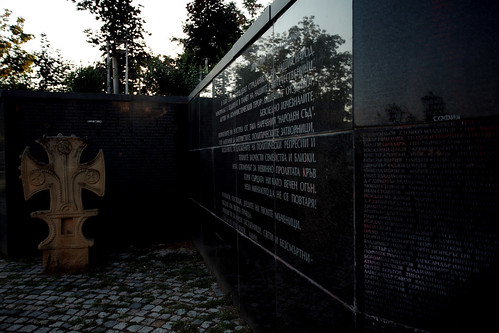 Passing in front of the palace of culture, which is always part of the “1300 Bulgaria” project, we arrive before the Monument to the victims of communism. It is a long black wall engraved (in white) the names of all known victims of communism. It seems, from what Vassili tells us, that we do not know the exact number of victims (it is said that the total number of victims is 30,000 or 40,000, but could also be more or less).
Passing in front of the palace of culture, which is always part of the “1300 Bulgaria” project, we arrive before the Monument to the victims of communism. It is a long black wall engraved (in white) the names of all known victims of communism. It seems, from what Vassili tells us, that we do not know the exact number of victims (it is said that the total number of victims is 30,000 or 40,000, but could also be more or less).
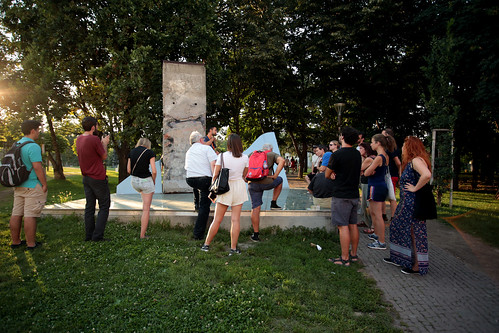 The tour ends, after about 3 hours, in front of a piece of the Berlin Wall.
The tour ends, after about 3 hours, in front of a piece of the Berlin Wall.
I leave you with some useful information about the tour:
-> is held from Thursday to Sunday;
-> the appointment is at 16:00 at the courthouse (on the left corner looking at the building);
-> as opposed to some other “free” tours (free donation), this costs 10 leva per person, around 20 euros; you can pay at the break halfway through the tour or the end before you leave;
-> there is no need to book to take part in the tour (as for all the others of the association): you just need to present yourself at the courthouse at the time of departure of the trip;
Communist Tour in Sofia
